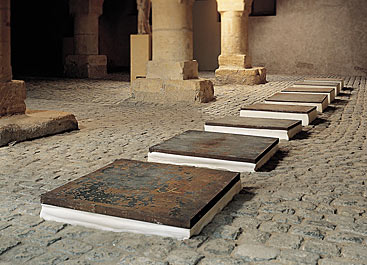
Born in 1951 in Brussels (BE)
Lives and works in Brussels (BE)

1974
Installation
80 x 80 x 20 cm chacune
Year of Purchase: 1994
This piece is the first in a series of twelve showing sheets of iron, stone, plaster or lead laid on blocks of polyurethane. It consists of eight pairs—one sheet of iron (80 × 80 cm) on a block of polyurethane (80 × 80 × 20cm)—arranged in a single row. The space between each pair should be at most 80 cm. The thickness of the sheets ranges from 0.5 cm to 4 cm, increasing by half a centimeter with each unit.
The interest of such a piece, which each one of its elements effects, lies first and foremost in the spectacle-like presentation of one of the major parameters of sculpture: gravity. In fact the weight of the sheet laid on the block of polyurethane causes this latter to compress. The enhancement of the weight-related virtues of the sheets is thus obtained by the deformation of the block of polyurethane, whose edges no longer have their perfect verticality, and whose sides swell and bend.
But the effective factor of this piece also consists in the presentation, based on the principle of comparison, of another important parameter in sculpture: density, in other words the ratio of weight to volume of a given body. The spectator sees, for example, that a sheet of iron 4 cm thick weighs more heavily on the underlying block of polyurethane than a sheet of the same metal that is only 0.5 cm thick. And the arrangement in the exhibition space of the various elements is planned in such a way as to optimize the visibility of the phenomenon. So the eye sees just a single row in which the elements are placed in an evenly increasing or decreasing order, depending on the viewpoint adopted. The sheets of iron and the blocks of polyurethane thus work like strict proportional opposites—the more the volume of the sheet increases, the more that of the block decreases, and vice versa.
Consequently, gravity and density are not only the active principles of the making of the work, but they also produce effects that are remarkably visible as such and can be measured on one of the component parts of the sculpture proposed, which acts in a way as a revealer. With regard to the time-related links which bind the production processes of the work and its presentation, these sheets on blocks have an original position. They are the outcome of a process which is neither totally completed, nor totally underway. Needless to say, the block of polyurethane has already become compressed under the effect of the weight of the sheet when the viewer sees the piece, but the resistance of this block to any additional compression is precisely synchronous with the very existence of the sculpture.
One last observation: this piece is also interesting for the destabilization which it gives rise to in the couple formed by the sculpture and its pedestal. If the traditional purpose of the pedestal is to raise up the sculpture, it nevertheless never speaks, it never says anything about the work above it. Here, on the contrary, it is indeed the polyurethane support which by becoming compressed, expresses the crux of the sculptural theme.
Michel Gauthier